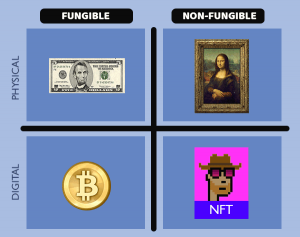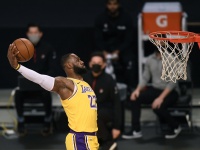NFT Art
NFT stands for Non-fungible Token, a type of token in which every token is distinct from one another.[1] Bitcoin would be an example of a fungible currency, with each Bitcoin in circulation being identical to any other Bitcoin, and one can be traded for another equally. NFT tokens have been issued for digital artwork. Artists can create digital art then issue an NFT for it. A buyer can purchase the art, which is non-fungible and hence unique. [2] NFTs have created a new method for artists to distribute unique digital art.[2]
Contents
History of Auctioning Art
Prior to the creation of the NFT and NFT marketplaces, art was and still is sold in a physical setting. Global art sales generate anywhere from 60 to 70 billion dollars per year.[3] From this pool, 20% of the sales come from auctions.[3] The traditional way art gets into the market is when a collector or institution decides that they want to put their piece up. Then auction houses can work with the seller to host events to auction their piece. The top three auction companies sorted by payout are Sotheby’s, Christie’s, and Phillips, respectively.[4] Companies like these then have a team of specialists who determine the authenticity and price of the piece. [3]
Market Place
Buying
There are many different websites one can use to buy NFT art. Some of the most used websites are Nifty Gateway, SuperRare, and OpenSea. [5] Art on these websites must be purchased with Ether, the native currency of the Ethereum blockchain. NFTs are created on the Ethereum blockchain, so once NFT art is purchased with Ethereum, ownership of that piece is now public information and verifiable on the public ledger. [5]
Selling
NFT art is also sold by creators on these marketplaces. The creation of the art is entirely up to the artist. Artists can sell any type of art, with the only requirement being that it is digital, whether that be a PNG, GIF, WEBP, MP4, or MP3. [6] Some websites function like traditional auction houses where there is a barrier to entry. On Nifty.com, artists must apply to have their work listed, and if accepted they will take 5% + 30 cents of every secondary sale. [7] Whereas on rarible.com, anyone can instantly sell their artwork, making it more of an open market. [6] The artist has to decide how many issues of their art they want to mint. Additionally, artists can set what percentage of royalties they want on secondary sales of a piece. [6]
Ethical Implications
Energy use
NFTs live on the Ethereum blockchain, and minting NFTs on the network requires servers, which consumes energy and produces carbon emissions. French Artist, Joanie Lemercier previously sold some of his work on Nifty Gateway and later found out that the sale of his work used 8.7 megawatt-hours of energy, equivalent to two years of energy use in his apartment. [8] From smart-energy.com “Renewables powers almost 40% of proof-of-work cryptocurrency mining”. [9] This is less than the majority. A large portion of crypto mining still relies on non-renewable energy. Yet, even if crypto was all renewable, cities like Missoula, Montana are stopping crypto mining as it is creating more competition for renewable energy and thus pushing away other big energy users to rely on non-renewable sources.[8]
Security
As NFTs are digital art anyone can copy art and sell it as their own. Recently artist RJ Palmer had his artwork copied and sold as an NFT, as someone just downloaded pictures of his artwork and sold them as their own.[10] So if the artist puts out art on the internet for free then anyone can claim it as their own. The artist needs to be the first to issue an NFT, producing more overhead for the creator. Once the token has been issued it is seen to be safer than the traditional way of selling art. Gregory Barber from a blockchain specialist from the University of Columbia and Wired said “with an NFT, the owner buys a verified token providing digital evidence that the art is theirs—a bit like an artist’s signature”. [8]So now you can verify all the past owners of a piece of art on the blockchain’s public domain. Though the blockchain is not entirely secure yet. A report from the MIT Technology Review claims that nearly $2 billion dollars worth of cryptocurrencies has been hacked. [11] A concern for collectors who fear that their ownership of their art may be hacked.
Artist control
Under an NFT an artist is rewarded greater for their art as they can set royalties for secondary sales of their original work. In the past, once ownership transferred, the artists no longer had rights over their art. Even after the artist dies, their family can receive commissions on their work. Vincent Van Gogh sold his first painting for 400 francs, and it was not until after he died that his paintings were worth millions.[12] Artists do not have to go through auction houses anymore to sell their artwork. As they could potentially be rejected, as auction houses like Christie’s do not have to accept your art.[13] Also, artists can have the power to set the price of their art and not have it set by auction houses. The specialist of the auction houses determines the value of your work, not you.
References
- ↑ Mitchell, Clark. "NFTs, explained" (2021, March 11). The Verge. Retrieved March 12, 2021.
- ↑ 2.0 2.1 Josie, Thaddeus-Johns. "What Are NFTs, Anyway? One Just Sold for $69 Million. (2021, March 11). The New York Times. Retrieved March 11, 2021.
- ↑ 3.0 3.1 3.2 Steven, Murphy. "Art explained: How do art auctions really work?" (2018, August 30). CNN . Retrieved March 11, 2021.
- ↑ Thierry, Ehrmann"The best auction houses". Art Price. Retrieved March 11, 2021
- ↑ 5.0 5.1 Stan, Horaczek "NFTs are blowing up the digital art and collectibles worlds. Here’s how they work."(2021, March 10) Popular Science . Retrieved March 11, 2021.
- ↑ 6.0 6.1 6.2 "Create single collectible" Rarible . Retrieved March 11, 2021.
- ↑ "Work With Us to Create and Sell your Own Nifties" Gemini. Retrieved March 11, 2021.
- ↑ 8.0 8.1 8.2 Gregory, Barber. "NFTs Are Hot. So Is Their Effect on the Earth’s Climate" (2021, March 06). . Wired. Retrieved March 12, 2021.
- ↑ Johnathan, Jones. "Renewables powers almost 40% of proof-of-work cryptocurrency mining" (2020, September 29). . smart-energy. Retrieved March 12, 2021.
- ↑ Anna, Lee. "Everything You Need to Know About NFTs—the Crypto Art Selling For Millions" (2021, March 11). esquire. Retrieved March 12, 2021.
- ↑ Mike, Orcutt. "Once hailed as unhackable, blockchains are now getting hacked" (2019, February 19). MIT Technology Review. Retrieved March 12, 2021.
- ↑ Erik, Velde. "WAS 'THE RED VINEYARD’ REALLY THE ONLY PAINTING VAN GOGH EVER SOLD?" (2020, February 13). . Van Gogh Studio. Retrieved March 12, 2021.
- ↑ "Selling at Christie's" . Christies. Retrieved March 12, 2021.

